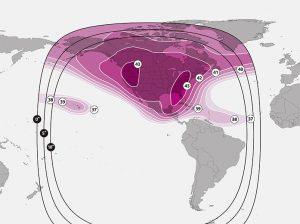Resource Library
Technical Services Menu
Westwood One Satellite Services offers the most detailed information about everything from backhaul methods to the semiannual Sun Outage. Follow the links on the left to learn more about common issues associated with Satellite Transmission.
If you have additional questions, or need immediate answers, call us at 888-HELP-450.
Azimuth and Elevation
The Azimuth & Elevation Calculator will help you determine the elevation and azimuth settings for your dish to receive transmissions from SES-11 at the longitude of 105 degrees west. Elevation is the angle above true horizontal that the antenna must be pointed to. Zero degrees elevation is pointing right at horizontal; 90 degrees elevation is pointing straight up. Azimuth is a compass direction, in degrees East of True North. True East is 90 degrees azimuth, True South is 180 degrees, and True West is 270 degrees. In most of the United States, the view of SES-11 is between 145 and 235 degrees East of True North.
You don’t need to know the exact location of True North or the exact azimuth to point the antenna. If your antenna lets you set azimuth and elevation without one affecting the other, you should set the elevation first, then sweep the southern sky until the satellite is found. If you are east of Denver, SES-11 will be in the southwestern sky. If you are west of Denver it will be in the southeastern sky. If you are at the same longitude as Denver, the satellite will be roughly due south of you.
Backhaul Methods
As you prepare to syndicate your program, you need to consider how your audio will reach our Network Operations Center in Denver, CO. The determination of your method will be dependent upon factors such as bandwidth quality, usage amount, redundancy requirements, flexibility and budget. Some choices are as follows:
- Private IP circuits such as MPLS, Metro E, Point-to-Point – End equipment: Comrex, Telos, Barix, Worldcast, Gates Air, Moseley, Tieline
- Internet IP delivery – End equipment: Comrex, Telos, Barix, Worldcast
- Leased circuits such as serial T-1 – Equipment for both ends is available from Gates Air (formerly Harris), Moseley
Our engineering staff can provide recommendations about which hardware and configuration best suits your needs.
SES-11 Specifications and Footprint
Specifications:
Footprint:
SES-11 typical EIRP performance (Image and information courtesy of SES)

SES-11 was successfully launched on October 11, 2017
Sun Outages
Each year, satellite downlink locations in the Northern Hemisphere experience sun transit outages during a three-and-a-half week period prior to the Spring Equinox and following the Fall Equinox. This phenomenon affects all geostationary satellites, and while it cannot be prevented, we can accurately predict when sun outages will happen.
Sun transit outage, or sun fade, occurs when the sun aligns directly above a satellite in orbit and a downlink antenna. The radiation from the sun interferes with the downlink signal from the satellite. During this period, digital satellite receivers may lose audio altogether. Sun transit outages have very little effect when the cycle begins each season, steadily increasing in intensity until a peak date, and then gradually decreasing in intensity before ending. The start and end dates of the sun fade cycle for your geographic location determines the severity of a sun fade event on any given day.
These maps show the single worst date and time for sun outages. You should plan on NOT receiving satellite audio for a period of 1 to 30 minutes a day, for about 8 days before and after the date shown. The outage is limited to a half-hour maximum window each day.
Sun outages are predictable, so it is important to be prepared. You should familiarize yourself with the affected dates and times in your area, and have alternate programming ready. Remember, sun transit affects all geostationary satellites. Outage times will vary based on location, date, and the characteristics of your downlink antenna.
If you have any questions about sun transit outage, please call our Technical Services at 888-HELP-450.